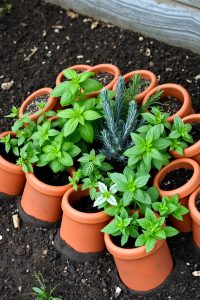
Budget Borders: 10 Inexpensive Garden Edging Ideas That Look Amazing

Garden borders can change the look of your outdoor space without draining your wallet. Simple edging ideas bring order to your garden, keep things neat, and add style at the same time. You don’t need fancy materials or expert skills to get started.
Even everyday items can turn into smart and attractive garden edges. Old bricks, wood scraps, and even recycled items work great for building borders. These ideas cost less and still look beautiful.
They also help keep mulch and soil in place while giving your yard a tidy finish. Want clean lines around flower beds or a soft edge near your lawn? There’s a low-cost solution for every style.
This list shares 10 easy and affordable edging ideas that can make your garden stand out. Each one brings charm, keeps things in shape, and saves money. Let’s explore the best budget-friendly ways to edge your garden.
10 Inexpensive Garden Edging Ideas
A tidy edge can change the whole look of your garden. It separates flower beds from the lawn, keeps soil in place, and adds structure. You don’t need to spend a lot to make your garden look great.
Many edging ideas use items you already have at home. Some just need a bit of effort and creativity. From simple stone borders to fun recycled materials, low-cost edging can look amazing.
These ideas help you save money and give your garden a personal touch. Let’s explore 10 inexpensive garden edging ideas that are easy to do and look great.
1. Brick Border Edging
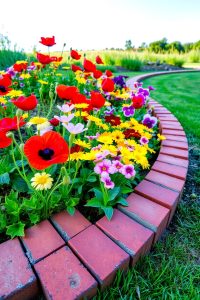
Old bricks can create a clean and strong edge for flower beds or paths. Lay them flat or tilt them at an angle. Bricks last a long time and handle weather well. You can often find old bricks for free or cheap at building sites or recycling centers. Place them tightly side by side to stop grass from growing into your flower beds.
2. Stone or Rock Edging
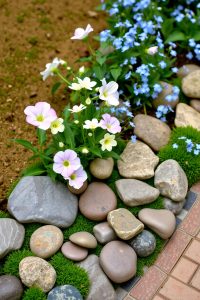
Stones and rocks give a natural and rustic look. Gather them from your yard or nearby areas. Pick rocks of similar size to make a neat line. Place them along the edge of your garden beds. This method costs nothing if you find the stones yourself. It also works well to hold soil in place.
3. Wood Log Edging
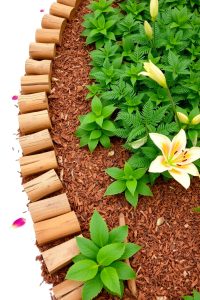
Short logs or tree branches cut evenly can form a pretty border. You can use tree trimmings or ask a local tree service for extras. Cut logs into equal lengths, stand them upright, and bury a third of each in the soil to keep them steady. This adds a woodsy feel to the garden.
4. Recycled Pallet Wood

Old pallets are easy to find and often free. Break them apart and cut the wood into small boards. Line the boards up side by side to create a low fence-like edge. You can leave the wood natural or paint it to match your garden style. Make sure the wood is safe for outdoor use.
5. Plastic Border Roll
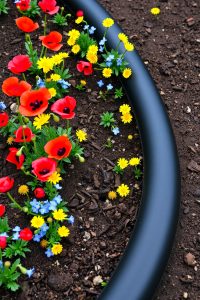
Plastic edging rolls are sold at most hardware stores and cost less than many other types. They bend easily and work well for curved or round garden beds. Just dig a small trench, place the edging, and press the soil back in. Choose a color that blends with the garden.
6. Recycled Bottle Edging

Glass or plastic bottles make fun and colorful borders. Bury the bottles upside down, neck-first, in the soil. Line them up side by side to form a wall around your garden bed. Mix different colors or use the same kind for a uniform look. This idea also helps reduce waste.
7. Concrete Paver Edging

Concrete pavers cost less than many other materials and come in many shapes and sizes. Use them to make straight or curved edges. Lay them flat on the ground or tilt them slightly for a more styled look. These pavers give a clean, modern finish to garden beds.
8. Rope or Twine Border
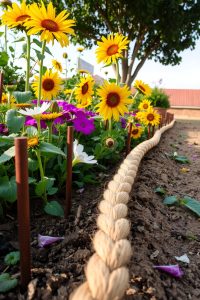
Thick rope can add a simple but stylish border. Lay the rope along the edge of your garden bed and pin it down with metal stakes. For more hold, dig a small trench first. Use natural jute or twisted cotton rope for a soft, earthy look. This works best for flat beds with low plants.
9. Metal Strip Edging

Thin metal strips, like aluminum or steel, create a sleek, tidy look. This edging bends to fit any shape and holds up well. You can buy strips pre-cut or repurpose old sheet metal. Just be careful of sharp edges while handling. Once placed, the metal blends in and gives a strong barrier for soil.
10. Terracotta Pot Edging
Broken or whole terracotta pots can make a charming garden edge. Turn broken pot pieces into mosaic-like borders or bury full pots halfway into the ground on their sides. They add color and texture, and work especially well in herb or flower gardens.
FAQs
1. What is the cheapest material for garden edging?
Rocks, bricks, and recycled materials like wood or bottles are usually the least expensive. Many can be found for free in your yard or neighborhood.
2. Does garden edging help with weeds?
Yes. A strong edge blocks grass and weeds from creeping into flower beds, making garden care easier.
3. Can I make edging from things I already have?
Yes. You can use old wood, bricks, bottles, or pots. Just make sure they are safe and stable for outdoor use.
4. How deep should I dig for edging?
Dig 2 to 4 inches deep for most materials. This helps hold the edge in place and prevents shifting.
5. How long does DIY garden edging last?
That depends on the material. Stone, metal, and brick last for years. Wood may need replacing sooner, especially in wet weather.
Conclusion
Garden edging doesn’t need to cost a lot to look good. With a little creativity, you can build borders that are both useful and beautiful. From old bricks to broken pots, many things around your home can become part of your garden design.
Edging helps keep your garden neat, adds style, and protects your plants. Try one of these inexpensive ideas to upgrade your garden and enjoy a fresh, clean look that lasts. Keep it simple, make it personal, and have fun building something your garden will love.

